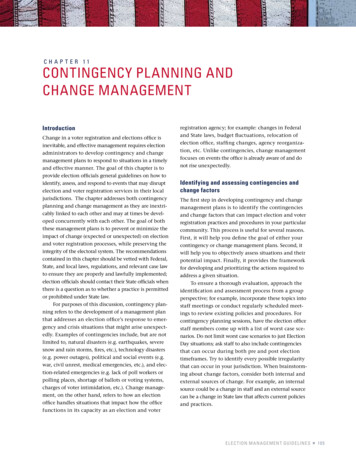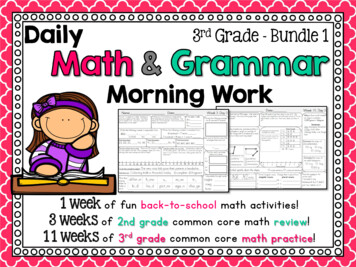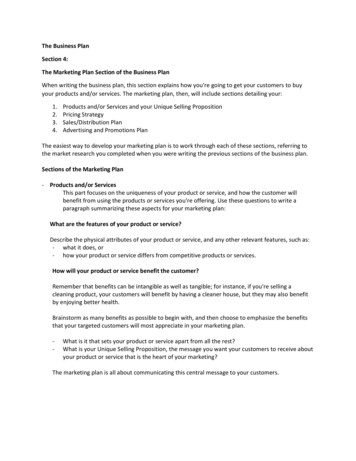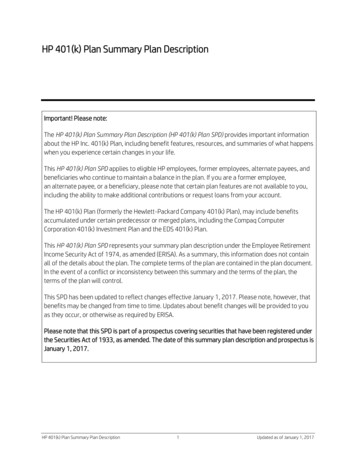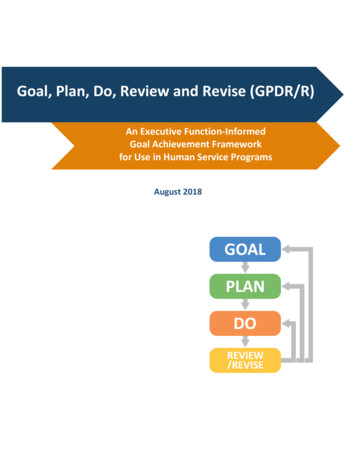
Transcription
Goal, Plan, Do, Review and Revise (GPDR/R)An Executive Function-InformedGoal Achievement Frameworkfor Use in Human Service ProgramsGoal,August 2018
TABLE OF CONTENTS (1)PrefacePreface . ivTHE GPDR/R FOUNDATIONChapter 1: Goal, Plan, Do, Review and Revise Workshop GuideBackground .1The Purpose of this Guide .1The Structure of this Guide .2Preview: Goal, Plan, Do, Review and Revise .3Table 1-1: GRDR/R Guide Overview.2Table 1-2: Effective Implementation of GPDR/R.4Chapter 2: GPDR/R and Executive Function SkillsIntroduction .5Executive Function Skills: What They Are and Why They Matter .5o What are Executive Function Skills? .6o The Relationship Between Executive Function Skills and Goal Achievement.8o Context Matters: How Living in Poverty Impacts Executive Function Skills.10What Organizations Can Do .11Table 2-1: Executive Skills Defined .7Table 2-2: The Relationship Between Executive Function Skills & Goal Achievement.8IMPLEMENTING GPDR/RChapter 3: Putting GPDR/R into PracticeIntroduction .13Goal: Looking to the Future .13o Key Concepts for Effective Goal Setting .14Plan: Creating a Roadmap for Change .15o Key Concepts for Effective Planning .15o Three Steps for Creating Effective Plans .16i
TABLE OF CONTENTS (2)Do: Put the Plan into Action .17o Key Concepts for Supporting Participants as They “Do” Their Plans Action .17Review and Revise: Looking Back, Moving Forward .19o Key Strategies for Guiding the Review Process .19o Key Strategies for Revising Goals and Plans .20Chapter 4: Staff Guides to Support GPDR/R ImplementationIntroduction .21Staff Guides: Facilitation and Learning-Centered Approaches (Descriptions) .21o The Role of Facilitation: Inviting Connections .23o Five Adult Learning Principles.24o Facilitation Tips.25Staff Guides: Implementation Support for GPDR/R (Descriptions).27o The Language of Goal Achievement .28o Tips for Effective Goal Setting .29o Trouble Shooting When Goals Aren’t Easily Identified .30o Apps to Help Participants Stay on Track .32o Support Strategies as Participants “Do” Their Plans .33Chapter 5: Participant Tools to Facilitate GPDR/RIntroduction .35Participant Tools (descriptions) .35o The Path to Achieve Your Goals: Goal, Plan, Do, Review, Revise (GPDR/R) .40o Life Areas .41o Goal Storming .42o My Goal Success Plan.43o Backward Mapping .45o My Action Plan (Traditional) .46o My Action Plan (Visual) .47o Potholes & Detours .48o Worksheet: Do the Plan .49o Worksheet: Review & Revise .50Figure 5-1: Participant Tools to Support Goal Achievement (Map) .36Chapter 6: Workshops and Group ActivitiesIntroduction .51The 8 Steps of DesignTM .52Goal Achievement Introductory Workshop .54ii
TABLE OF CONTENTS (3)Action Planning Workshop .64Making GPDR/R a Habit .70Resume Workshop .73Appendix: Executive Skills ProfileGuidance for Administering the Executive Skills Profile .81Worksheet: Executive Skills Profile & Scoresheet.84ReferencesReferences .91iii
PREFACEThe development of approaches that explicitly focus on building and supportingexecutive function skills and core adult capabilities in human service and job searchprograms largely has grown out of efforts by the Center on the Developing Child atHarvard University to elevate the important role that adults play in producingbreakthrough outcomes for children. The Annie E. Casey Foundation, wanting toadvance the development of this framework for helping adults become successfulworkers and parents, has funded several initiatives aimed at identifying ways in whichemployment and related human service programs can use executive function and selfregulation principles and concepts to improve outcomes for parents. In that vein, theyhave provided the funding for the development of this guide for human services staff.In the development of this manual, we have drawn on the work of Richard Guare,neuropsychologist and applied behavioral analyst and Peg Dawson, educationalpsychologist, authors of the Smart But Scattered series, Phil Zelazo, a neuroscientist atthe University of Minnesota, Lauren Kenworthy, a neuropsychologist and her colleaguesat Children’s National Medical Center (Goal, Plan, Do, Check), Sarah Ward and KristenJacobsen, speech and language therapists at Cognitive Connections (Ready, Do, Done),Silvia Bunge, a neuroscientist at Berkley, and Gabriele Oettingen, psychology professor atNew York University and author of Rethinking Positive Thinking.LaDonna Pavetti, Vice President for Family Income Support at the Center on Budget andPolicy Priorities led development of the GPDR/R model and the creation of this manual.Valerie Uccellani, Owner and Senior Partner at Global Learning Partners and MeganStanley, independent consultant, acted as co-creators. In the development of this guide,we have benefited from the input from a number of our colleagues and partners in thefield who were willing to test out the tools and pilot some of the group activities. We allowe an incredible debt to Dick Guare who schooled us in how executive skills play out inevery aspect of adults’ lives.August, 2018iv
THE GPDR/R FOUNDATIONChapter 1: Introduction and Preview of GRDR/RBackgroundRecent advances in our understanding of the core capabilitiesthat lead to adult success have encouraged the development ofnew approaches for organizing and delivering human serviceprograms. Key components of these core capabilities areexecutive function and self-regulation skills -- foundational skillsthat help us focus, make decisions, set goals, control impulses,make and execute plans and revise and adjust them whennecessary. These skills begin developing early in life, but aremalleable into adulthood. These skills are what allow us to setand achieve goals that are meaningful to us.This guide takes practical solutions developed by executivefunction experts for use primarily in schools and adapts themfor use in job search and human service programs. We haveintegrated various approaches into one comprehensive adaptable multi-step framework - Goal, Plan, Do, Review and Revise (GPDR/R) that makes explicit the steps that lead tosuccessful goal achievement.Many stress factors, like living without enough resources to make ends meet, cancompromise these skills and growing up in highly stressful environments can impact theirlong-term development. The good news is that we can design our programs to build onindividuals’ strengths and compensate for weak skills while simultaneously providingopportunities to strengthen skills over time through practice, practice and more practice.The Purpose of this GuideThis guide provides guidance for how human services staff can integrate the GPDR/Rframework into existing programs, with a special emphasis on job search assistanceprograms. It is designed to introduce human services staff to practices that lead tosuccessful goal achievement and provide concrete ideas for how to integrate thosepractices into existing programs. The strategies presented here can be used in individualmeetings or group settings.1
The GPDR/R framework works best when used in its entirety, again and again: set a goal,craft a detailed plan, put the plan into action, review progress and revise. As the figureon the previous page shows, each step builds on the last and leads to the next. For manyprograms, this process will seem familiar – and it is. What an executive function lensgives us is a more intentional way of guiding participants to successfully achieve theirgoals.The Structure of this GuideThis guide is designed to provide you with: (1) background information that will help youto understand the link between goal achievement and executive function skills; (2) aspecific (but adaptable) approach to goal achievement that builds on what we knowabout the factors that increase the likelihood that individuals will successfully achievetheir goals; (3) specific tools that you can use to implement the framework in yourprogram; and (4) group activities that you integrate into existing programs to teach andpractice the use of the GPDR/R framework.Table 1-1 below provides a raodmap to the materials presented in this GPDR/R Guide:TABLE 1-1: GPDR/R GUIDE OVERVIEWThe GPDR/R FoundationChapter 1:Provides an introduction, an overview of GPDR/R and what makes this frameworkdifferent from current practiceChapter 2:Introduction to executive function skills and why they matter for goalachievementImplementing GPDR/RChapter 3:Guidance for implementing ech component of the GPDR/R frameworkChapter 4:Tools for staff to build their knowledge and expertise in implementing GPDR/RChapter 5:Tools to use with participants to execute each step of the GPDR/R processChapter 6:Activities to use in groups that strengthen skills leading to goal achievement.AppendixAdministering the Executive Skills Profile2
Preview: Goal, Plan, Do, Review and ReviseGoal, Plan, Do, Review, and Revise (GPDR/R) is a multi-step goal achievement frameworkthat, if practiced regularly and with fidelity, will make setting and achieving goals easier –and more effective. If practiced enough, it can also help to build key executive functionskills necessary for adult success. We will explore executive function skills more deeply inthe next chapter, but in short, these skills are ones we use and need for future-orientedendeavors and everyday tasks that rely on planning, self-control, and monitoring skills. Inaddition to directly building skills, GPDR/R is designed to facilitate the development ofsupportive relationships and reduce stress, both of which play an important role in thedevelopment and use of executive function skills.The steps of GPDR/R always happen in the same order: Goal: Set a goal – something an individual wants to accomplish and is withintheir reachPlan: Create a roadmap and action plan for how to achieve the goal and identifyobstacles and solutionsDo: Put the plan into actionReview & Revise: Look back and assess progress; make a plan for movingforwardThe GRDR/R approach to goal achievement focuses on the importance of facilitating aprocess that helps participants: (1) look to the future to identify something they want toaccomplsh that is meaningful to them – something that will motivate them to make useof the rsources your program has to offer – and (2) helps them to create a path forwardthat maximizes their chanes of success. Creating that path forward requires helpingthem visulaize the future while simultaneously assessing their current situation toidentify what steps they need to take to get to where they want to go and to plan aheadfor what might get in the way. It recognizes that achieving our goals is not a linearprocess – it takes time and there will be inevitable setbacks along the way.The GPDR/R intentionally builds on processes that employment and other human serviceprograms already do every day, but approaches those processes differently. Keydifferences from regular practice include the following: Staff act as facilitators, helping participants to set goals that are meaningful tothem and within their reachGoals are broken down into small steps that are achievable within the timeavailableDetailed action plans identify when, where and how each task will be completedParticipants (not staff) identify potential obstacles and strategies for overcomingthem before they occurOngoing support is provided when participants are putting their plans into action3
Regular meetings are intentional and purposeful and focused on reviewing andrevising goals and plansEffective implementation of GPDR/R rests on the following: (1) creating and supportingresponsive relationships; (2) strengthening core life skills; and (3) reducing sources ofstress. (See Table 1-2.) In the next chapter, we provide more detail on the skills that arenecessary for successful goal achievement. Then, in the remaining chapters we providemore detailed guidance on how to effectively integarate GPDR/R into your day-to-dayactivities.TABLE 1-2: EFFECTIVE IMPLEMENTATION OF GPDR/RCreate and Support Responsive Relationships Start with the future, not the past: What are your hopes and dreams? What can wedo to help you identify and achieve them? Put the participant in control: they decide what matters to them; what they want toachieve Act as a facilitator – provide guidance; help participants identify their own prioritiesand solve their own challenges Continue to provide support when participants are putting plans into action;encourage teamworkStrengthen Core Life Skills Embed common goal achievement processes and language across all programcomponents; use consistently Model goal achievement processes whenever possible Provide guidance to help participants break tasks down into small steps Help participants develop and write down detailed action plans Help participants to identify and develop solutions to obstacles before they occur inthe context of what they want to achieve Help participants monitor their behavior and actions and make adjustments based onwhat they learnReduce Sources of Stress Provide resources to help participants meet their basic needsSet realistic expectationsCelebrate every success, no matter how smallCreate an organizational culture that encourages workers to do their job differentlyReduce program complexity and smooth the path to success whenever possible4
THE GPDR/R FOUNDATIONChapter 2: GPDR/R and Executive Function SkillsIntroductionExecutive function skills – also known as adult capabilities orexecutive skills-- are a set of skills that we use to set andachieve our goals. They play a significant role in determiningwhether we succeed at school, parenting and work. Becausegoal achievement is effortful work, it places significantdemands on our executive function skills. We can increasethe chances of successfully helping our participants achievetheir goals by reducing the demands on their executivefunction skills and building them through practice. We canreduce the demands on executive functions by modifying theenvironment (e.g., changing our expectations so they alignwith individuals’ executive function skill strengths andweaknesses) or by modifying tasks to make them easier (e.g.,reducing the steps it takes to obtain child care, helping peopleto fill out complicated forms). We can also reduce thedemands on executive function skills by creating routines –like GPDR/R-- that we can use over and over again. Through repeated practice, routines requireless and less effort – and they build skills in the process.Executive Function Skills: What They Are and Why TheyMatterA growing body of research highlights the important role that executive function skills play inhelping adults achieve success in the workplace and at home.1 They are the skills that help us tocarry out day-to-day tasks and achieve life goals that are important and meaningful to us. Theyare the skills that help us plan, control our responses to things and monitor our actions. Theyalso are the skills that we use to remember important information and follow multi-stepprocesses or instructions. Executive function skills begin developing in early childhood and their1Center on the Developing Child at Harvard University (2016). Building Core Capabilities for Life: The ScienceBehind the Skills Adults Need to Succeed in Parenting and the Workplace. Retrieved fromwww.developingchild.harvard.edu.5
natural development ends at about the mid-20’s. However, they can be improved throughpractice and use throughout adulthood – and even into old age.This introduction is intended to highlight the important role that executive function skills play ingoal achievement, but you do not need to become an expert on executive function skills toeffectively use GPDR/R. By implementing GPDR/R, you are encouraging the use of executivefunction skills, creating an environment that recognizes how easily these skills are taxed,providing support when they are weak, and building them through practice.What are Executive Function Skills?While there isn’t one standard definition of executive function skills, most researchers agreethey are a set of cognitive skills that help us organize and manage our resources and set andachieve goals, making them essential for adult success. As a starting point for understandinghow we can use executive function concepts and principles to enhance the work of job searchand other human service programs, we consulted with Dr. Richard Guare, a neuropsychologistand certified behavior analyst who has written numerous books on executive function with hisco-author, Peg Dawson.2 (Guare and Dawson use the term “executive skills” rather thanexecutive function skills in their work. Because we draw so heavily on their work, we often usetheir terminology in this guide.) Their work draws on years of developing and implementingpractical strategies to help children, adolescents and young adults with executive skillweaknesses to successfully set and achieve their goals.Broadly speaking, the 12 skills that are the focus of Guare and Dawson’s work (See Table 2-1) fallinto three broad categories: Planning. Planning, organization, and time management are a set of related skills thathelp us to create a roadmap to get from where we are to where we want to go.Self-control. We rely on our self-control to follow the roadmap to where we want to go.Self-control requires consciously directing our actions and behaviors towards the futurewhile controlling our automatic responses (such as fight or flight) which might take us offcourse. When we lack the resources we need to meet our basic needs, we tend to bevery present-oriented, making it difficult to exert the self-control necessary to achievefuture-oriented goals.Monitoring. Regularly assessing our behavior is what allows us to learn from ourexperiences and to make adjustments if things are not going the way we would like.2For example see, Peg Dawson and Richard Guare. The Smart but Scattered Guide to Success. New York, New York:The Guilford Press, 2016.6
Table 2-1: Executive Skills DefinedPlanning andPrioritizationTask InitiationStress ToleranceGetting started without delay.The ability to begin projectswithout undueprocrastination, in an efficientor timely fashion.Managing your stress. The ability towork in stressful situations and tocope with uncertainty, change, andperformance demands.OrganizationResponse InhibitionWorking MemoryKnowing where I put things. Theability to create and maintainsystems to keep track ofinformation and materials.Seeing the consequence beforeI say or do something. Thecapacity to think before youact – the ability to resist theurge to say or do somethingallows us the time to evaluatea situation and how ourbehavior might impact it.Remembering what I did and what Ineed to do. The ability to holdinformation in memory whileperforming complex tasks. Itincorporates the ability to draw onpast learning or experience toapply to the situation at hand or toproject into the future.Time ManagementEmotional ControlMetacognitionKnow about how long a task willtake and what the deadline is. Thecapacity to estimate how muchtime one has, how to allocate it,and how to stay within time limitsand deadlines. It also involves asense that time is important.Keeping my cool whenfrustrated. The ability tomanage emotions in order toachieve goals, complete tasks,or control and direct behavior.Evaluating how you’re doing. Theability to stand back and take abird's eye view of yourself in asituation, to observe how youproblem-solve. It also includes selfmonitoring and self-evaluativeskills (e.g., asking yourself "Howam I doing?" or "How did I do?")Sustained ng what steps to take. Theability to create a road map toreach a goal or to complete atask. It also involves being able tomake decisions about what isimportant to distinguish what isand is not important.Paying attention, even when Idon’t feel like it. The capacity tomaintain attention to a situationor task in spite of distractibility,fatigue, or boredom.Sticking with your goal. Thecapacity to have a goal, followthrough to the completion ofthat goal, and not be put off ordistracted by competinginterests.Going with the flow, acceptingchange. The ability to revise plansin the face of obstacles, setbacks,new information, or mistakes. Itrelates to adaptability to changingconditions.Table Key: Planning Skills, Self-Control Skills, Monitoring Skills7
If you would like to learn more about your own executive skills and consider helping participantsto identify their exutive skills strengths and weaknesses, you can use the Executive Skills Profilewhich is inlcuded in the Appendix, along with instructions for how to use it.When integrating an executive skills focus into your program, it is important to keep thefollowing in mind: All of us have executive skill strengths and weaknesses;Not all people who have lived in poverty have weak executive skills;Ongoing inequities based on gender, age, race, ethnicity and social standing may taxthese skills and make successful goal achievement more difficult; and,When providing guidance and support, it is important to build on strengths as much assupport weaknesses.The Relationship between Executive Function Skills andGoal AchievementExecutive skills are important because they are the skills we need to direct our behaviors andachieve our goals. By better understanding the link between executive skills and goalachievement, we can more effectively target our limited resources to activities and actions thatwill best support program participants in setting and achieving their goals. As Table 2-2 showsand the information provided below illustrates, we use different skills at each phase of the goalachievement process.Table 2-2: The Relationship between Executive FunctionSkills and Goal AchievementGPDR/R ComponentExecutive Skills Most Relied UponGoalMetacognition, working memoryPlanPlanning/prioritization, organization, time management,working memoryDoTask initiation, response inhibition, time management,sustained attention, working memory, flexibility, organization,persistence, stress tolerance, emotional control, cognitiveflexibilityReview & ReviseMetacognition, working memory, flexibility8
Goal: We use working memory to remember past experiences and metacognition toevaluate those experiences. That’s what helps us to come up with goals that aremeaningful – we avoid things that we don’t like and do more of what motivates us tomove forward. Successfully helping a participant identify a meaningful goal requireshelping people to identify what matters to them and what successes and strengths theycan draw upon to maximize their chances of success. Plan: Our planning and prioritization skills are what help us to break goals down into thesmall steps. We use our organization skills to gather the resources we need tocomplete a task and to keep them in a place where we can find them. We use timemanagement skills to help us estimate how long a task will take and to decide when wewill do it. We draw on working memory to identify what else we need to do and toremember the steps so we can prioritize them. One of the most important things wecan do when working with participants is to help them break big goals down into smallsteps that allow them to experience success from the very beginning of the process. Do: Executing a plan draws on many executive function skills, most of which involvepracticing self-control to direct our behavior in a purposeful way. Task initiation allowsus to get started on a task. Time management allows us to wisely use the time we haveavailable. Response inhibition allows us to avoid distractions and stay focused on thetask at hand. Sustained attention helps us to stick with a task until it is complete. Goaldirected persistence helps us to complete each step along the way until we’ve reachedour goal and to stick with the goal even when the going gets rough. Stressmanagement helps us to not get too overwhelmed when faced with competingdemands and to proactively identify ways to reduce the stress in our lives. Emotionalcontrol help us to keep our emotions in check. When we encouter stumbling blocks, itis cognitive flexibility that allows us to problem-solve to keep us on track. Much of theresponsibility for doing a plan lies with the participant, but providing continuedreminders and support and encouragement can do a lot to help them stay focused onwhat they are trying to accomplish. Review & Revise: When reviewing our progress towards a goal, we once again draw onworking memory and metacognition skills which help us to remember what we did (ordidn’t do) and why and assess what did and ddn’t work. When revising a goal, we alsodraw on cognitive flexibility as that is the skill that allows us to abandon goals that aretoo hard or no longer meaningful to us and come up with new goals – or to develop anew plan if the previous one didn’t produce the results we wanted. We also drawheavily on metacognition because we are digging deeper into what matters to us andusing it to plan for the future. We often don’t take the time to review with participantswhat they accomplished and to help them decide what they want their next steps to be.9
Context Matters: How Living in Poverty ImpactsExecutive Function SkillsThe development of and our ability to access and use our executive function skills are influencedby the context in which we live our lives. The impact of poverty on adults’ executive functionskills begins in early childhood and continues into adulthood. Understanding how povertyimpacts the development and use of executive function skills provides important insights intowhy goal achievement can
The Annie E. Casey Foundation, wanting to . These skills begin developing early in life, but are malleable into adulthood. These skills are what allow us to set . This guide is designed to provid


